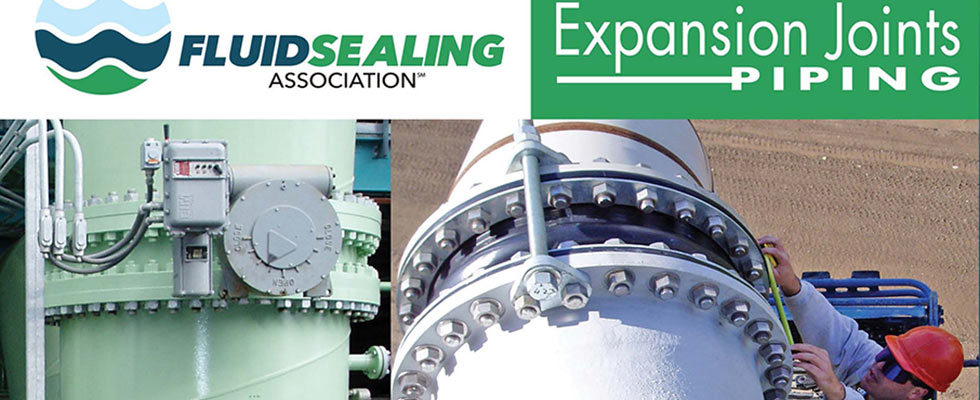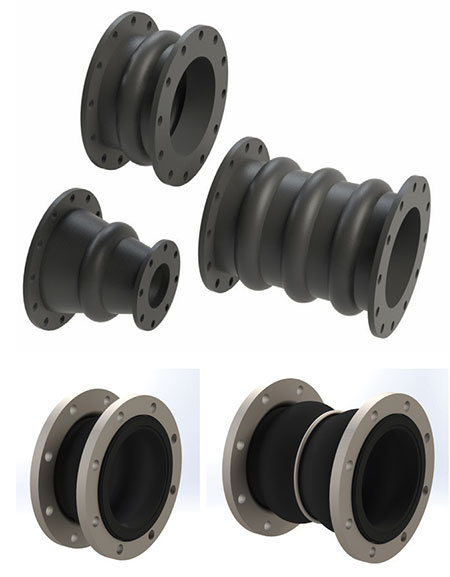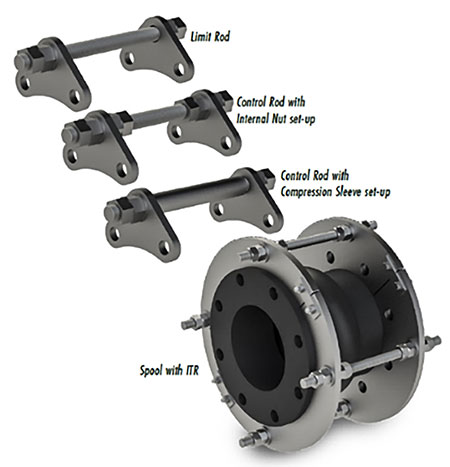
When introducing consumers to rubber expansion joints, several initial questions come to mind. What are rubber expansion joints? What is the function of rubber expansion joints? Are there different types? What are the capabilities? How do I install one? The answers to these and additional questions can be found in the Technical Handbook for Expansion Joints Piping 8.1, which has been newly released by the Fluid Sealing Association.
The handbook is a technical guideline developed by the expansion joints piping division of the Fluid Sealing Association. This division created the Technical Handbook as a valuable reference source of pertinent information and factual data for the thousands of engineers whose daily concerns are designing piping systems and overseeing installations. The handbook is a compilation of construction standards and a guide for specifying and purchasing rubber expansion joints. The information provided is based upon a wealth of associated knowledge collected from these different member companies.
The handbook provides the following information regarding rubber expansion joints: the definition of what a rubber expansion joint is, their different types and styles, commonly available elastomers and the various design configurations and accessories for rubber expansion joints. It also provides technical design data and information regarding common design conditions for the different types of expansion joints and guidelines on how to install and maintain rubber expansion joints.
What Are Rubber Expansion Joints & What Is Their Function?
The definition of a rubber expansion joint per the handbook is a flexible pipe connector fabricated of natural or synthetic elastomers, fluoroplastics and fabrics and, if necessary, metallic reinforcements to provide stress relief in a piping system due to thermal and mechanical vibration and/or movements. Expansion joints can be incorporated into the design of a piping system to solve anticipated problems of vibration, noise, shock, corrosion, abrasion and stresses. The expansion joint will be used to dampen the anticipated vibration and/or noise transmission from centrifugal pumps or other equipment that may cause excess vibration, which may be transmitted through the system. The expansion joint can also compensate for axial, lateral, angular and torsional movements that occur due to thermal changes or hydraulic surge effects by strategically positioning the expansion joints in the system. Some common places where rubber expansion joints are often seen in a piping system are on the inlet and discharge of pumps, in cooling water circulation and heat exchanger systems or anywhere vibration dampening, flexibility and/or reduction in pipe stresses are needed.
Types of Rubber Expansion Joints
There are several types of rubber expansion joints available in various design configurations and elastomers, depending on the requirements of the application. The handbook discusses in detail the different types of rubber expansion joints; however, the two most common types of rubber expansion joints are the spool type and molded sphere type. The spool type rubber expansion joint typically incorporates a full-face rubber flange as an integral part of the expansion joint’s body. The full-face rubber flange is of sufficient thickness to form a tight seal against the mating flanges without the use of gaskets. This style of rubber expansion joint is available in many different design configurations, from the very common single and multiple open arch designs to the filled arch or lined versions for slurry/abrasive applications. Other design configurations of the spool type include the concentric and eccentric reducing versions to the sleeve type which forgo the full-face rubber flanges and instead employ sleeve ends designed to slip onto the mating pipe for a watertight seal.

The other most common type of rubber expansion joint, the molded sphere type, incorporates the movement and vibration dampening capability of a spool type expansion joint into a compact and robust device. The distinguishing features of the molded sphere type expansion joint are the shape of the body, metal floating flanges and beaded end seal. The beaded end seal is different compared to the full-face rubber flange typically found on the spool type expansion joint, providing a different style of sealing with similar characteristics to the spool type design. The most common design configurations of the sphere type include the single sphere and double sphere designs.
These different types of expansion joints also come with different accessories to facilitate their function. The most common accessories are the control units, which have availability in a few different styles depending on the application. They are designed to restrain the pressure thrust load developed from an expansion joint when it is pressurized and/or to restrict the movement of the expansion joint to within its design capabilities. With that being said, a new question arises. What is pressure thrust from an expansion joint?
When describing pressure thrust, consider equating it to blowing up a balloon. As the balloon inflates, it expands outward. An expansion joint will do the same thing if unrestrained, and depending on how the piping system is supported, guided and anchored, as the rubber expansion joint is pressurized, it will create a pressure thrust load that will be exerted on the system. If the system is unrestrained, then this pressure thrust load can cause the expansion joint to expand past its design capabilities. For unrestrained/unanchored systems, these control units will be required to restrain this pressure thrust load to ensure the expansion joint does not operate beyond its design capabilities. The control units also come in a few different design configurations, depending on what kind of movement is being restrained. These range from limiting the axial extension of the expansion joint only to limiting both the axial extension and compression or allowing the expansion joint to only angularly deflect.

Where to Find More Technical Information
What if you are looking for technical information about rubber expansion joints? The handbook is a wealth of knowledge for the design phase of a piping project. The handbook has design data for the common types of rubber expansion joints including their maximum temperature ratings for the different elastomers, typical pressure characteristics of the different styles of rubber expansion joints and their common movement and associated spring rate capabilities. This information is valuable in the design phase of a piping system when determining the correct style of expansion joint to use. This technical information can help to make an informed decision when determining design choices in a piping system regarding expansion joint placement and how the expansion joint will act based on the design requirements of the system.
Important questions arise when determining design choices. For example, will the expansion joint compensate for the required axial growth/contraction of the piping without exerting too much of a stress load on a nozzle, a pipe header or a pump flange? The technical data found in the handbook, along with a pipe stress analysis, can determine the answer to this question, and the design can be modified or a different expansion joint may be used so the design is within allowable stress tolerances. Making these determinations at the design phase and specifying the style of expansion joint required for the specific application/installation reduces the chance an incorrect expansion joint will be used.
If interested in learning more about rubber expansion joints, the Fluid Sealing Association’s newly released Technical Handbook for Expansion Joints Piping 8.1 is your reference guide for expansion joint piping. Download a copy at www.fluidsealing.com.
We invite your suggestions for article topics as well as questions on sealing issues so we can better respond to the needs of the industry. Please direct your suggestions and questions to sealingsensequestions@fluidsealing.com.

